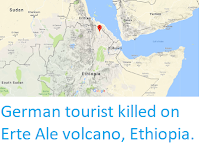Extremophilic organisms live, and often thrive, in environments that would be immediately lethal to most other life, such as boiling hot springs, hyperardid deserts, in strong acids, or in the presence of high levels of heavy metals or salts. The study of such organisms helps scientists to understand the limits at which life can exist, and can potentially give us insights into the potential for life on other planets. The Danakil Depression of northern Ethiopia is extremely
volcanically active, with dozens of volcanoes fed by an emerging
divergent margin along the East African Rift; Erta Ale is on the
Ethiopian Rift, the boundary between the Nubian Plate and the Danakil
Microplate. This creates a series of volcanic systems within what is one of the hottest and driest deserts on Earth. The Dallol Geothermal Springs of the Danakil Depression are thought to have formed in 1926 following a phraetic eruption (explosion caused by water coming into contact with hot magma). The water that reaches the surface here is typically at boiling point (~100°C), highly acidic (pH ~0), and saturated with salts and heavy metals and salts, creating a series of pools of varying colours, which reflect their metal contents. The system has been proposed as a possible Earthly analogue of the Nili Patera Caldera on Mars, which is interpreted as an ancient hydrothermal volcanic system.
In a paper published in the journal Scientific Reports on 27 May 2019, Felipe Gómez of the Centro de Astrobiología, Barbara Cavalazzi of the Dipartimento di Scienze Biologiche, Geologiche e Ambientali at the Università di Bologna, and the Department of Geology at the University of Johannesburg, Nuria Rodríguez, also of the Centro de Astrobiología, Ricardo Amils, again of the Centro de Astrobiología, and of the Centro de Biología Molecular “Severo Ochoa” Cantoblanco, Gian Gabriele Ori of the International Research School of Planetary Sciences at the Universitá d’Annunzio, and the Ibn Battuta Centre at the Université Cadi Ayyad, Karen Olsson-Francis of the School of Environment, Earth and Ecosystems Sciences at the Open University, Cristina Escudero and Jose Martínez, also of the Centro de Biología Molecular “Severo Ochoa” Cantoblanco, and Hagos Miruts of the Department of Earth Sciences at Mekelle University, describe the presence of Extremophilic Micro-organismss from the Dallol Geothermal Springs.
The site contained numerous 'chimneys', formed where superheated water reaches the surface and precipitates out its mineral content. Gómez et al. extracted samples from one of these chimneys, as well as the pool surrounding it. The water within the chimney was found to be pH 0.25 and 86 °C, while that in the pool was pH 2.42 and 47 °C.
Panoramic view of the sampling sites (D9: central small chimney and D10: water from the blue pool at the bottom of the chimney). Gómez et al. (2019).
DNA was successfully extracted from the salt precipitates at the chimney; this was found to have come from an unknown Nanohaloarchaean (member of a group of very small, extemophilic Archaeans), which appears to be related to an as-yet-unnamed strain from a salt pond in Alicante, referred to as Candidatus Holaredivivus sp. G17. Scanning electron microscopy of salt crystals from the chimney revealed the presence of small micro-organisms entombed within precipitated silica minerals, which may suggest that the micro-organisms play a role in the mineralisation process.Hot Sp
(A) General view of the sampling site, (B) the small chimneys (temperature of water 90 °C. (C) D9 sample from a small chimney in (A). (D–L) SEM and (M–O) Scanning TEM images of sample D9 showing the morphologies of ultra-small microorganisms entombed in the mineral layers. Gómez et al. (2019).
See also...
Follow Sciency Thoughts on Facebook.








